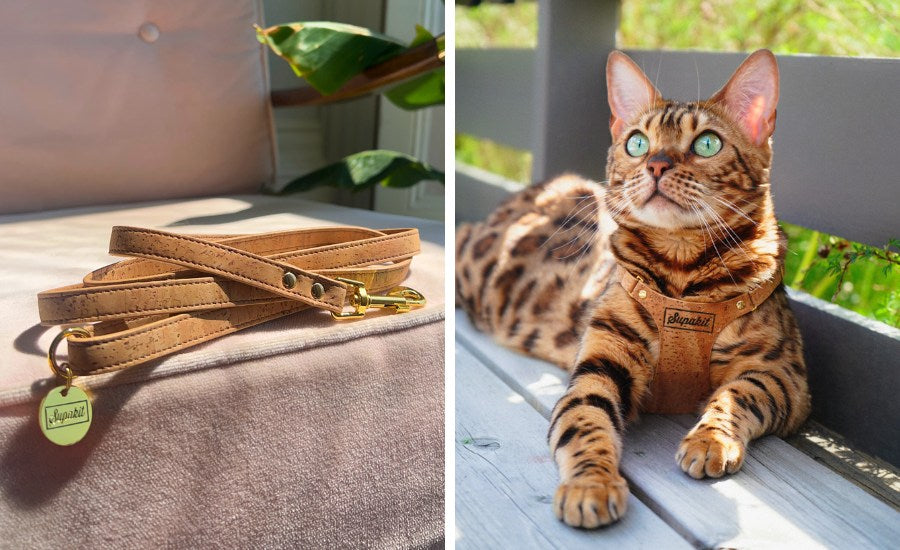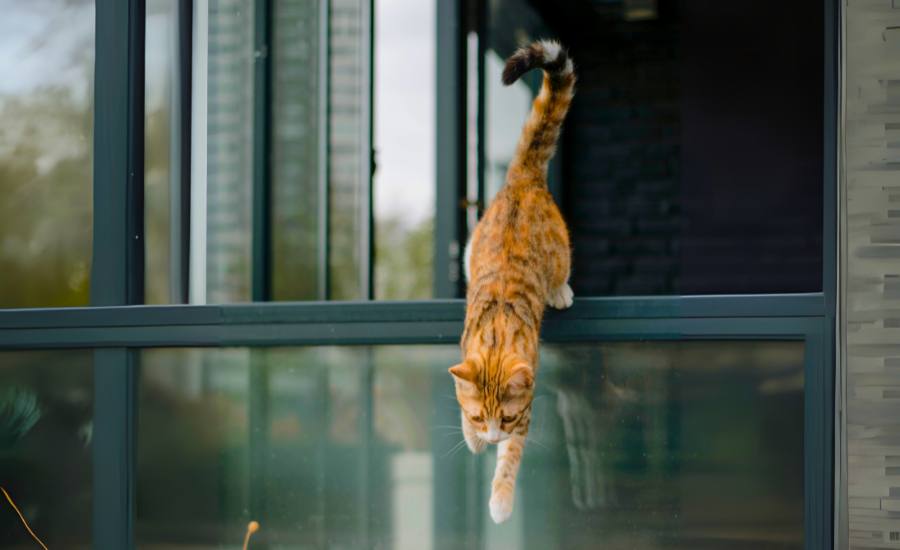Moving House With A Cat: How To Have A Cat-Friendly Move
Moving house with a cat can be a stressful experience, for humans and cats alike! For a cat, their home is the core of their territory, a little slice of the world that’s truly theirs. If you’ve ever watched your cat’s daily routines you’ll know that they spend a huge amount of time every day rubbing their face and body on furniture and door frames, to leave scent signals for any other passing cat that this is their patch. When all’s well in their territory our cats will feel safe and secure. But when we move home with our kitties and transplant them outside of their established territory, it can be an unsettling experience for them.
Fortunately, our cats are adaptable creatures, and with the right support moving with cats doesn’t need to cause long-term upheaval. Here’s how to make moving house with a cat as stress-free as possible:
Before the move: Getting your cat ready

Set up a ‘safe room’ in your existing house
As your moving date approaches, gradually begin moving all of your cat’s key resources into a single room of the house. These should include:
- Their existing litter tray
- Existing food and water bowls
- Their preferred sleeping location (e.g. cat bed, blanket or armchair)
- Somewhere to scratch (e.g. a scratching post or cat tower)
- Some favourite toys
- If possible – somewhere to climb / explore (e.g. an existing cat tower or tunnel)
- The travel carrier that you’ll be using during the move
It can also be helpful to plug in a pheromone diffuser such as Feliway Classic inside your cat’s ‘safe room’. These diffusers mimic the scent marks left by your cat when they rub to mark their territory, so by filling the air with this scent it can help a cat feel like their territory is already well-marked and secure.
When choosing the safe room try to find a room in your home that will be easy to pack up and empty of your belongings in advance (so that you won’t need to go in and out of the room many times on moving day).
In the weeks and days leading up to your move, you can leave the door open and let your cat retreat there if they’re feeling anxious about the changes occurring in other parts of the house. On moving day itself, you’ll want to confine your cat to this room and leave the door closed while you pack up and empty the remainder of the house. It can be handy to pop a note on the door so that anybody helping with the move knows that your cat is inside and shouldn’t be disturbed!
Set up a ‘safe room’ in the house you’re moving to
If you have access to your new home prior to the move, then this is the perfect opportunity to set up a matching ‘safe room’ inside the new house (if not, no problem, you can do this on moving day!).
Pick a room that you won’t need constant access to on moving day, and make sure that it’s secure for your cat with no opportunities for escape or harm. It’s also a great idea to clean this room if you can – focusing on areas that are at your cat’s height. That way, you can remove any scent marks left by previous kitty inhabitants and give your cat a clean slate for marking their new territory.
The idea is that on moving day itself, you’ll simply transport your cat and all of their key resources from one safe room to another, causing a minimum of upheaval for them.
Begin carrier and travel training
Moving with cats doesn’t just involve navigating territorial changes. It can also often involve travel. If your cat isn’t completely accustomed to travel, or if they have some fear or anxiety around elements of the process e.g. they don’t like getting in their carrier, or they are unsettled in the car, then it’s well worth embarking on some training in advance. Here are some resources you may find helpful:
- The Trainable Cat (Book) by Sarah Ellis and John Bradshaw has a great section on carrier training;
- Our #catchat with Tabitha Kucera has top tips for car training with cats who are anxious travellers;
- The Supakit Academy Harness Training Course covers cat carrier training in full.
If your cat is a very anxious traveller or if your move involves travelling long distance with cats, it is also worth discussing the move with your veterinarian. They may be able to put you in touch with a feline behaviour consultant to assist with acclimating your cat to elements of travel that currently scare them, or they may consider it appropriate to give your cat a prescription for medication to manage their anxiety levels during the move.
Keep to existing routines if possible
Cats are creatures of habit. If you possibly can, try to keep their daily routine unchanged during your preparations for the house move. If there are set times of day when they are fed, engage in play, or get time to rest undisturbed, try to stick to these during the moving process.
Prepare visible ID for your cat
It’s important to make sure your cat’s new home and (safe room within that home) are safe and secure, to minimise the risk of escapes. However, escapes can occur, and if they happen, you want to make sure your cat has everything they need to make it home again.
The most important element of this is a form of visible ID. Microchips are great, but they can only be scanned with a special microchip scanner at the vet or a shelter. If your cat wanders out of your new home, it’s much more likely to be a member of the public who encounters them first, so a visible form of ID gives them the opportunity to identify your kitty and contact you to bring them home.
The best way of achieving this is via a well-fitting breakaway cat collar, carrying an ID tag with your contact numbers and new address on. If your cat is new to wearing a collar, be sure to order this up well in advance, so you can introduce them to their collar with plenty of time before your move.
On moving day: How to introduce your cat to their new home

With moving day finally here, you’re going to have a lot on your hands. Here’s how to make the day run as smoothly as possible for you and your cat:
Stick to your cat's regular schedule
If you can it’s well worth sticking to your cat’s usual routines on moving day, unless your veterinarian has advised otherwise. At the very least, consider your cat’s toileting preferences. If they always use their litter at 9am each morning, it’s a great idea to try and plan to move them after this, when they’ll be feeling a little less frantic about where their litter tray is located!
The only addition to your cat’s routine that I would recommend is engaging them in a particularly long session of play prior to the move (providing they are fit and well and usually enjoy play). Well-exercised kitties are generally more docile kitties later in the day, so a few extra minutes of feather toy action – or whatever floats your cat’s boat – is an investment in time that can pay dividends later.
Put your cat’s new ID on
If you haven’t done so already, moving day is an important day to make sure your cat is wearing their collar and visible ID, so make sure they’re wearing this before embarking on any travel.
Get your cat settled in their carrier & pack up their things
When you’re ready to move your cat, encourage them into their carrier with a food treat or toy, then gently close the openings. Gather up all of your cat’s key resources (we’re talking their litter tray, food and water bowls, scratching post, preferred sleeping area… all of the things that you had gathered for them in their safe room), and transport them with your cat to their new home. If you had a sign made up for the door of the safe room to notify people that your cat is inside, take this with you too – it will come in handy for attaching to the door of your cat’s new safe room!
Put your cat in their new safe room
If you’ve already been able to gain access to the house to set up your cat’s new ‘safe room’, that’s great! If not, simply find a quiet room of the house that you won’t need to continuously access on moving day, check it’s safe and escape-proof for your kitty, and pop them in with their key resources.
Pop another sign on this door to let anyone helping you with the move know that there’s a kitty inside and they’re not to be disturbed, and then open up their carrier and let your cat explore the new room at their leisure.
After the move: How to make your cat feel comfortable in their new home

Help your cat scent mark their new territory
Remember all of that scent marking that your cat had established in your old place by rubbing on things? We’ve managed to bring as much of that with us as we can by bringing along their preferred items. But we’ve inevitably left a lot of it behind in their old territory, which will make our cat feel a bit unsure of their surroundings at first. Given time, they’ll build up nice familiar scent marks in their new territory too, but we can give them a helping hand in two ways.
The first is by using plug in pheromone diffusers, such as Feliway Classic, that contain the same scent mark pheromones that our cats use to mark things. When we plug one in, it will fill the air with those pheromones and help our cats feel like this is a territory they’ve already marked – we don’t know exactly how cats experience this but I like to imagine that it gives them a faint sense of déjà vu, that feeling that I’ve been here before…
The second thing we can do is literally help them out with the scent marking. To do this, take a clean dry cloth (or a sock – whatever you can get your hands on on moving day!) and use it to stroke your cat, focusing on the side of their face and chin to gather up those scent molecules. Then simply wipe the cloth on items in the home, focusing on areas at cat height. Pick the sort of places where you can imagine your cat enjoying to rub like the corners of furniture and door frames.
Update your cat’s veterinary and microchip details
With your move complete, now is the time to register your cat with a new veterinarian (if you’ve moved out of your previous vet’s catchment area), and don’t forget to update their microchip address details too!
Prepare for kitty jet lag
Despite our best efforts, moving day and the days after will likely be an unsettled time for your cat, and it’s highly likely that they won’t settle down for as many snoozes as they would do on an ordinary day. As a result, cats can develop disrupted sleep patterns, and you may find your cat developing some night time meowing or other new nocturnal behaviours. Just like in humans, being tired can also make your cat pretty cranky!
The trick to navigating this period with your cat is to avoid leaping out of bed to comfort or play with them at night. As tempting as it might be, your cat will quickly learn that this is a fun thing to do, and you can end up perpetuating the behaviour. Instead, ignore your cat at night, but work on making their days as full and active as can be – full of play and enrichment with activity feeders, places to climb and explore – so that come night time they’re nice and worn out and ready for sleep. Before you head to bed, it’s a great idea to engage your cat in a period of play, followed by their dinner as this mimics the natural process of hunting then eating…. followed by sleep!
Prepare for accidents
When our cats feel anxious, particularly about their territory, it’s not uncommon for their toileting to go a little awry – and you may encounter the odd toileting accident while your cat is still settling in. The best way to handle this is to come prepared. First, make sure your cat has access to at least one but preferably a couple of litter trays, in nice quiet areas of the house that they seem settled in, full of clean litter that they’re used to using. But if they do choose to toilet in an inappropriate place, you can also make the clean up easier by investing in waterproof mattress covers that you drape over areas that they may target such as furniture or beds (soft materials are usually a target). If they do go somewhere they shouldn’t, don’t shout or get angry as this can increase their anxiety and make the problem worse. Simply review their litter tray set up to make sure it’s working for your cat, and consider limiting their access to the room where the accident occurred for a while until you can settle them back in a good routine of using their litter tray.
Expand your cat’s territory gradually
Keep your cat confined to their safe room for a day or two once you first arrive. This gives them the best chance of establishing a new territory, without feeling overwhelmed by the scale of their new environment. Your cat will pretty much let you know when they’re ready to venture further by meowing at the door or scratching at it, at which point you can start to let them out of their safe room (but make sure they still have access to it, because it’s where all of their favourite things are!). If you can, give your cat access to their new home in stages, opening up additional rooms to them once they show signs of being settled in the areas they already have access to.







